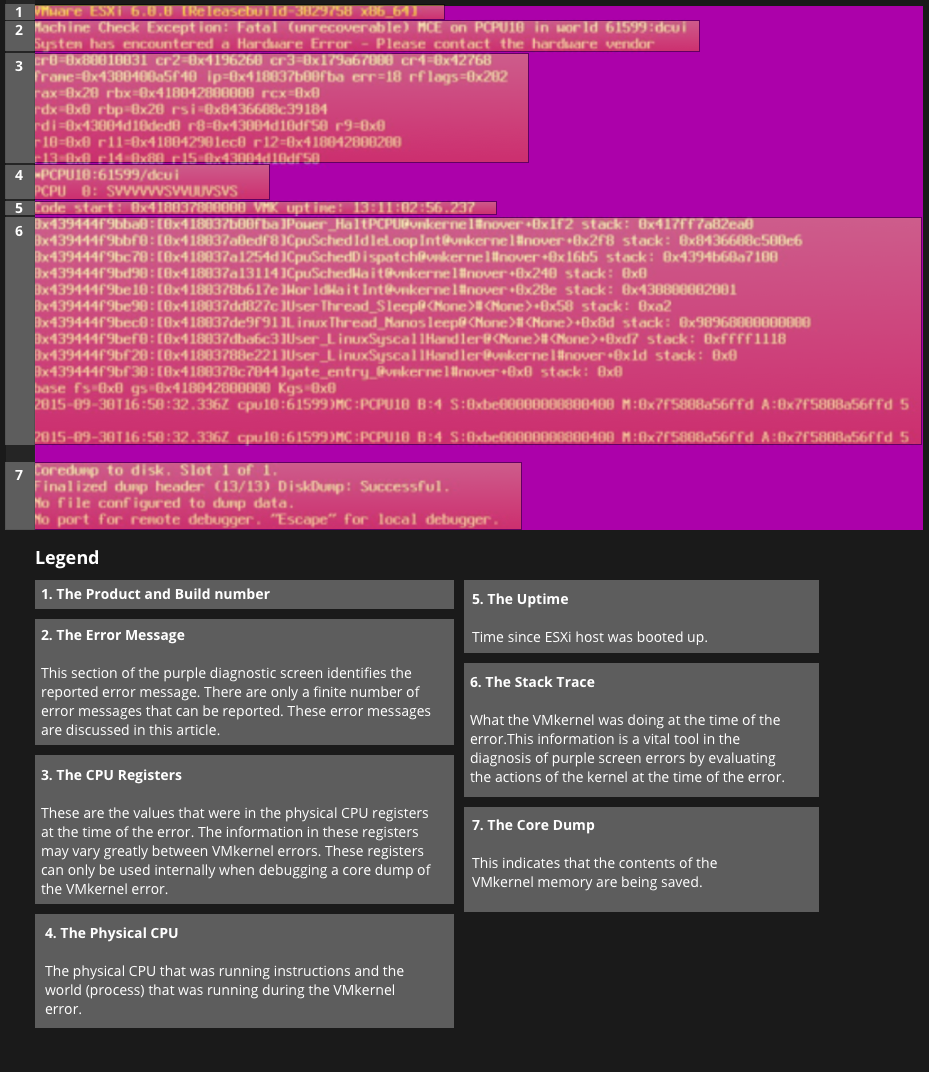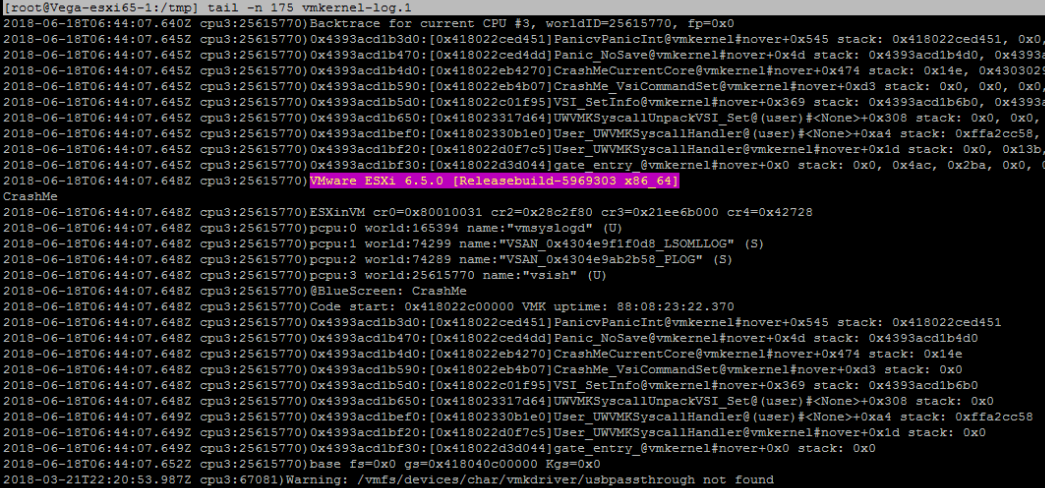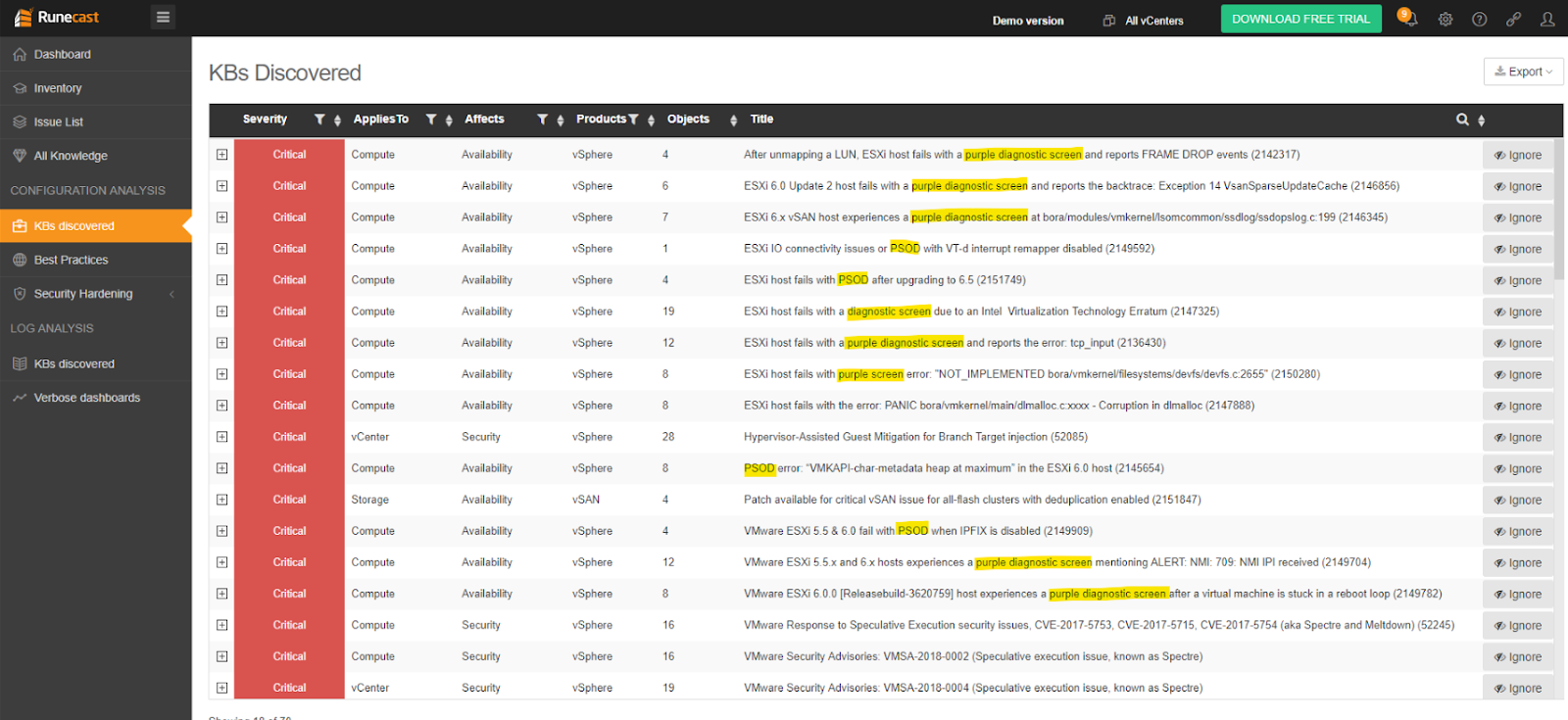Why Does Rca Firmware Update Request Interrupt Viewing
This article is available in the following languages:










Contents
What is PSOD?
Why does it happen?
What’s the touch on?
What to practise when it happens?
How to prevent it?
TL;DR
The near troublesome aspect of a PSOD is that it makes yous lose trust in your infrastructure and the anxiety it creates. Until you don’t solve the root cause, the thought that this can happen again or on some other server tin keep you up at nighttime.
Apply Runecast Analyzer (Gratuitous Trial) to check if any of your hosts are affected by conditions that can cause the VMware purple screen of death.
What is PSOD?
PSOD stands forPurple Screen of Diagnostics, often referred to every bitImperial Screen of Decease: from the more than knownBlueish Screen of Death encountered on Microsoft Windows.
Information technology’s a diagnostic screen displayed by VMware ESXi when the kernel detects a fatal error in which it either is unable to safely recover from, or cannot continue to run without having a much college take a chance of a major data loss.
It shows the retentivity country at the fourth dimension of the crash and also additional details which are important in troubleshooting the cause of the crash: ESXi version and build, exception type, register dump, backtrace, server uptime, mistake messages and information about the core dump (a file generated after the the error, containing farther diagnostic information).
This screen is visible on the console of the server. In order to run across it, you will need to either be in the datacenter and connect a monitor or remotely using the server’s out-of-band direction (iLO, iDRAC, IMM… depending on your vendor).

DID YOU KNOW?
The screen is referred to as either Regal or Pink , but in fact the color is Night Magenta (RGB:171,0,171 | CMYK:0.00, 1.00, 0.00, 0.33)
Why does PSOD happen?
The PSOD is akernel panic. Even though nosotros all know that ESXi is not based on UNIX, the panic implementation fits the UNIX definition. The ESXi kernel (vmkernel) triggers this condom measure in response to an effect/mistake which is unrecoverable and would mean that continuing to run would pose a loftier risk for the services and VMs. To put information technology simply: when the ESXi hosts feels it became corrupted, information technology commits “seppuku” and, while haemorrhage its royal claret, writes a suicide letter detailing why information technology did it!
The almost common causes for a PSOD are:
1. Hardware failures, mostly RAM or CPU related. They normally throw out a “MCE” or “NMI” error.
- “MCE” – Machine Check Exception, which is a mechanism within the CPU to detect and report hardware issues. There are important details for identifying the root cause of the issue in the codes displayed on the purple screen.
- “NMI” – non-maskable interrupt, which is a hardware interrupt that cannot be ignored by the processor. Since NMI is a very of import message most a HW failure, the default response starting with ESXi 5.0 and later is to trigger a PSOD. Earlier versions were just logging the error and continuing. Aforementioned as with MCEs, purple screen caused past NMI volition provideimportant codes that are crucial for troubleshooting.
2. Software bugs
- improper interactions between ESXi SW components (ex:KB2105711)
- race weather (ex:KB2136430)
- out of resources: retentiveness, heap, buffer (ex:KB2034111,KB2150280)
- infinite loop + stack overflow(ex:KB2105522)
- improper or unsupported configuration parameters (ex:KB2012125,KB2127997)
3. Misbehaving drivers; bugs in drivers that endeavour to access some incorrect index or non-existing method (ex:KB2146526 ,KB2148123)
DID YOU KNOW?
Yous can even trigger manually a PSOD for testing purposes or if you are only curious to see information technology happen.
Log in to the ESXi host via DCUI or SSH with a privileged account and run:vsish -e set /reliability/crashMe/PanicApparently a test system is recommended, ideally a virtual nested ESXi so you tin easily observe the console. Also brand sure yous finish reading this article to understand the implications of this activeness and the outcome on your test organisation.
What’s the impact of PSOD?
When the panic occurs and the host crashes, itterminates all the services running on it together withall the virtual machines hosted. The VMs arenot gracefully shutdown, but rather abruptly powered off. If the host is part of a cluster and you’ve configured HA, these VMs will be started on the other hosts in the cluster. Besides the outage and the unavailability of the VMs during the time they are downward, some critical applications like database servers, message queues or backup jobs may be affected by the “dingy” shutdown.
Additionally, all other services provided by the host will be terminated, and so if your host is a fellow member of a VSAN cluster, a PSOD volitionimpact vSANevery bit well.
For me, the most troublesome aspect of a PSOD is that information technology makes you lot lose trust in your infrastructure and the anxiety it creates, at least until you get to the bottom of it. Ok, yous tin recover past rebooting and may accept HA or even FT so the affect may non be devastating… but until you lot don’t solve the root cause, the thought that this tin happen again or on an some other server tin go on you up at nighttime.
What to do when PSOD happens?
ane. Clarify the imperial screen message
One of the almost important things to practice when you have a PSOD is totake a screenshot. If you are connecting remotely(IMM, iLO, iDRAC,…) to the console information technology will be piece of cake taking a screenshot, but if you lot have to go to the datacenter, you lot may need to literally take out your telephone and snap a flick of the screen. There’due south a lot of useful information almost the cause of the crash in that screen.

two. Contact VMware back up
Before you commencement further investigation and troubleshooting it is advisable to contact VMware support, if yous have a support contract. In parallel with your investigation they will be able to assist you lot in making the Root Cause Analysis (RCA).
three. Reboot the afflicted ESXi host
In order to recover the server yous volition need to reboot it. I would also propose keeping information technology in maintenance mode until you perform the full RCA, place the crusade and fix it. If you lot can’t afford keeping information technology in maintenance mode, at least fine tune your DRS rules and then that simply un-important VMs volition run on it, and so that if another PSOD hits the impact will be minimal.
4. Get the core dump
After the server boots upwards you lot should collect thecoredump. The coredump, also calledvmkernel-zdump is a file containing logs with similar, just more detailed information to that seen on the royal diagnostic screen and volition exist used in farther troubleshooting. Even if the cause of the crash might seem obvious from the PSOD message that you analyzed in step 1, it is advisable to ostend information technology past looking at the logs from the coredump.
Depending on your configuration you may take the cadre dump in one of these forms:
a. On the scratchpartition
b. Every bit a
.dump file on i of the host’s datastores
c. As a
.dump file on the vCenter – through the netdump service
The coredump becomes especially important if the configuration of the host is toautomatically reset after a PSOD, in which case you will not become to come across the message on screen.
You can copy the dumpfile out of the ESXi host using SCP and then open it using a text editor (similar Notepad++). This volition contain the contents of the retentivity at the time of the crash and the first parts of it contain the messages you saw on the majestic screen. The whole file may exist requested by VMware support, but y’all tin can onlyextract the vmkernel log, which is a bit more … digestible:

5. Decipher the error
Troubleshooting and Root Cause Analysis tin can make one feel like Sherlock Holmes. PSODs can sometimes turn into a Arthur Conan Doyle inspired story, but in most cases it’southward a pretty straightforward process where information technology volition exist hard to get to the 5th “why” of the 5 Whys technique.
The most important symptom, and the 1 you lot should starting time with, is the mistake message generated by the purple screen. Luckily, the number of mistake letters that can be produced is finite:
Exception Type 0 #DE: Divide Mistake
Exception Type 1 #DB: Debug Exception
Exception Type 2 NMI: Not-Maskable Interrupt
Exception Type 3 #BP: Breakpoint Exception
Exception Type 4 #OF: Overflow (INTO instruction)
Exception Type 5 #BR: Bounds check (Jump instruction)
Exception Type 6 #UD: Invalid Opcode
Exception Type seven #NM: Coprocessor not available
Exception Type 8 #DF: Double Fault
Exception Blazon x #TS: Invalid TSS
Exception Type xi #NP: Segment Not Present
Exception Type 12 #SS: Stack Segment Error
Exception Type thirteen #GP: Full general Protection Fault
Exception Type 14 #PF: Page Fault
Exception Blazon 16 #MF: Coprocessor error
Exception Blazon 17 #AC: Alignment Check
Exception Type 18 #MC: Automobile Bank check Exception
Exception Type 19 #XF: SIMD Floating-Signal Exception
Exception Type 20-31: Reserved
Exception Type 32-255: User-defined (clock scheduler)
Since the kernel panic is handled by the CPU, for more data about these Exceptions come acrossIntel 64 and IA-32 Architectures Software Developer’s Manual, Book ane: Bones Architecture andIntel 64 and IA-32 Architectures Software Developer’southward Manual, Book 3A.
The most common cases are covered in separate VMware KB articles and I will just maintain a reference table of such errors here since the manufactures are very detailed and well documented. And so employ this tabular array as an index for the PSOD errors:
| Components | Location | What is it |
| System messages |
/var/log/syslog.log
|
Contains all full general log letters and can be used for troubleshooting. |
| VMkernel |
/var/log/vmkernel.log
|
Records activities related to virtual machines and ESXi. Nearly PSOD relevant entries will be in this log, and so pay special attending to it. |
| ESXi host amanuensis log |
/var/log/hostd.log
|
Contains data about the amanuensis that manages and configures the ESXi host and its virtual machines. |
| VMkernel warnings |
/var/log/vmkwarning.log
|
Records activities related to virtual machines. Picket for heap exhaustion(Heap WorkHeap) related log entries. |
| vCenter amanuensis log |
/var/log/vpxa.log
|
Contains data virtually the agent that communicates with vCenter, so you can apply it to spot tasks triggered by the vCenter and might have caused the PSOD. |
| Vanquish log |
/var/log/shell.log
|
Contains a record of all commands typed, and so you lot tin correlate the PSOD to a command executed. |
How to prevent PSOD?
Most of the software related PSODs are resolved past patches, so brand sure you are up to date with the latest versions.
Make sure that your servers are on VMware’due southHardware Compatibility Checklist, together with all the devices and adapters. This will protect from some of the unexpected hardware related issues, but it volition also ensure that VMware back up will be able to support you lot in case of a PSOD.
As described above in “Why information technology happens”, misbehavingdrivers are too an frequently cause of PSODs, so information technology’s imperative to regularly bank check vendors’ support websites for updated firmware and drivers and especially for the documented PSOD causing drivers to respond as soon equally possible by upgrading them.
At Runecast, we regularly analyze the unabridged VMware Noesis Base (kb.vmware.com) which consists of more 30,000 articles. We are extracting actionable insights from the KBs in order to proactively make virtualized infrastructures more resilient, secure and efficient. We are very familiar with the PSOD and are able to place near of the preconditions that can lead to this problem. Pastproactivelyanalyzing your environment, Runecast Analyzer will help you lot steer away from these issues, so y’all can take the peace of mind that well-nigh PSODs lurking in your surroundings are prevented.

>>Download Runecast Analyzer gratis trial
About the writer:

Aylin Sali (Runecast CTO)
Aylin Sali is a virtualization and cloud enthusiast with more than than x years of It feel and an overwhelming want for automation. He is a VCAP DCA & DCD and 5x vExpert.
Aylin is on Twitter as:@V4Virtual
Ebook How to Bargain with PSOD
Everything you need to know almost the PSOD (The Royal Screen of Decease), in an ebook by Runecast CTO Aylin Sali.


